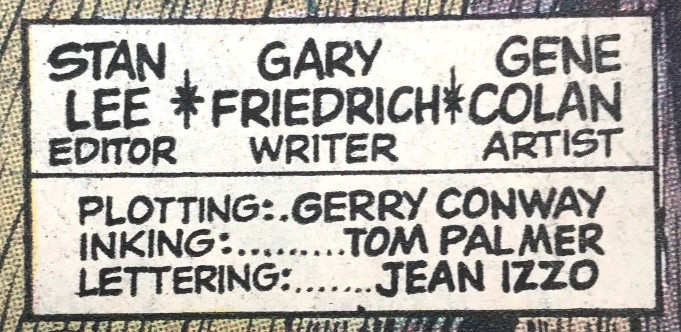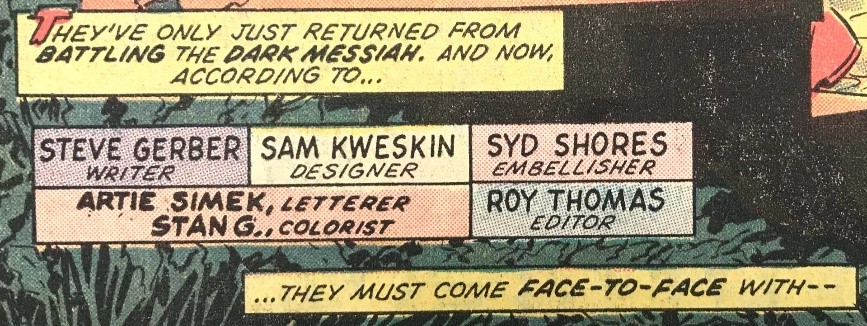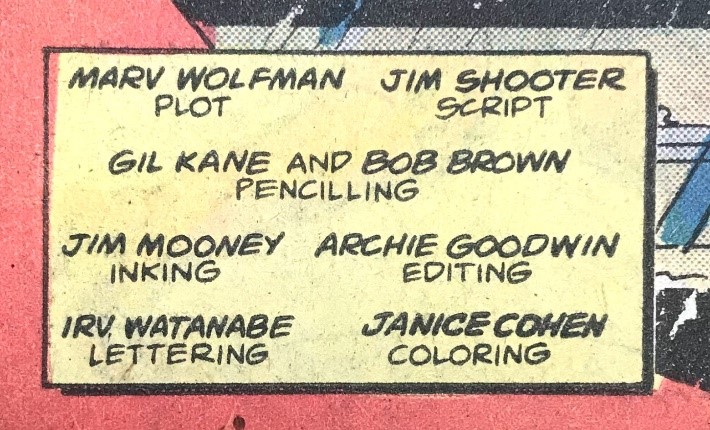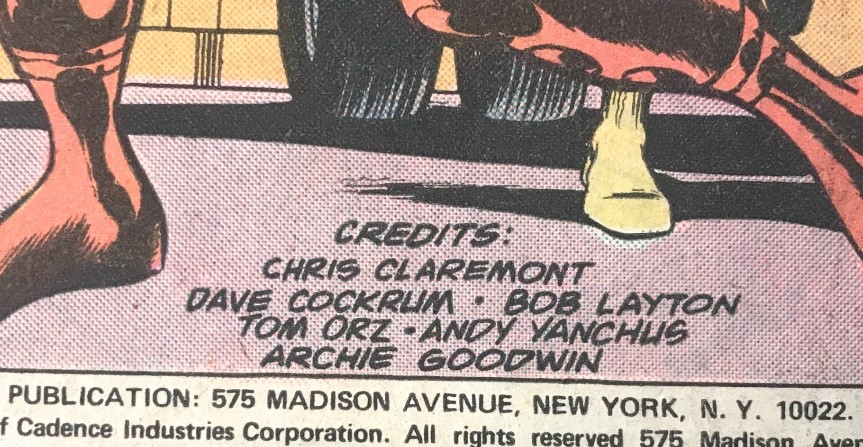Comic Books and Graphic Novels
Scope
Beinecke has a large collection of comics from mainstream, indie, and underground publishers. The collection comprises many different formats, including serials in individual issues, collected editions, and graphic novels. A wide variety of genres are represented, including superhero stories, science fiction, fantasy, mystery, erotica, nonfiction, and adaptations from other media. Comics are cataloged according to RDA and CONSER, with exceptions described below.
Housing
Titles with 5 or more issues will be housed in folders and put into Hollinger boxes. Titles with fewer than 5 issues will be stored in Gaylords. If adding to a series housed in the “comic folders” with clear windows, rehouse in regular folders.
The following guidelines are used when marking volumes:
- Mark on verso of last page, lower right hand corner. The lower left hand corner is the alternate location when the lower right hand corner is unusable.
- If the last page is unmarkable (e.g., too dark or shiny or filled with text or illustrations), mark the verso of the first usable page from the end.
Classification and Call Numbers
Comics new to Beinecke will be given a year/number call number. Comics currently classed in Folio year/number call number will not be reclassed, but only one copy of each issue will be kept.
Types of Comics
- Ongoing series – a standard comic book series intended to continue for an indeterminate amount of time. They might run for decades and hundreds of issues or be canceled after only a handful of issues. These are cataloged as serials.
- Limited series – a comic book series of a fixed, predetermined number of issues. These vary widely in length, but often run from three to ten issues. They can usually be distinguished from ongoing series by having both the current issue number and total issue number on the cover and/or in the indicia (e.g., “No. 4 of 6.”). Because they aren’t indefinite publications, they should be cataloged as multi-volume monographs (i.e., on a single record).
- One-shot – a single issue comic book that is intended to be a one-off publication. They look like normal comic book issues in format, often with the standard indicia of the publisher; some even include a volume and/or issue number. They may self-identify on the cover with “one-shot” or “special.” If they have volume or issue numbering, it will be 1 (or occasionally 0), and the indicia will not include a publication frequency. If the one-shot is associated with an ongoing series, it will have a unique issue title (e.g., Lumberjanes: somewhere that’s green) and will not be included in the ongoing numbering of the series. If in doubt whether what you have is a one-shot, checking a reference such as the Grand Comics Database might help. Because they are one-time publications, they should be cataloged as monographs.
- Trade – short for “trade paperback,” this refers to a collected edition of issues from a comic book series. They might have generic volume numbering (e.g., Giant days volume 2) or include a unique title (e.g., The unbeatable Squirrel Girl vol. 3: squirrel, you really got me now). These can usually be distinguished from original graphic novels by the presence of a reprint note (e.g.,. “Contains material originally published in single magazine form as The unbeatable Squirrel Girl #1-6 and Howard the duck #6.”). They can be cataloged either as monographs or serials. The decision of whether to catalog as a monograph or serial can be made based on whether the volume collects an ongoing or limited series, the existing records in OCLC, and consultation with the curator.
- Original graphic novel – a graphic work that is not a reprinting of previously serialized material. These are cataloged as monographs.
008 Field
For Nature of Entire Work (serials records) or Contents 1 (monograph records), code as 6 [Comics/graphic novels].
Preferred Source of Information
Title, issue enumeration and chronology, and publisher for comic books are taken from the indicia, which is usually found either at the bottom of the first page, or the bottom of the verso of the front wrapper; in contemporary comics, it may also be found on one of the final pages. While not addressed in either RDA or CONSER, the indicia is similar to a masthead (see CONSER 3.2.2.1.d). Trades and original graphic novels can have an indicia in addition to a title page.

(Indicia from Sandman, no. 60, June 1994)
Keep in mind that series titles (especially those that are the name of a character) get reused over time, so always check to see if you need to include a uniform title. Trace the cover title if it differs from the indicia title.
For both serials and monographs, note when the title is from the indicia.
| 500 | ‡a Title from indicia. |
| 588 | 0 | ‡a 1 (April 1993); title from indicia. |
Identifying and Tracing Creators and Contributors
The terminology used to identify comics creators varies widely (often changing issue to issue in one series). Below is a list of the most common terms and what they mean.
- Writer – the person who writes the dialogue and any other text, as well as plotting out the story (providing scene by scene or panel by panel descriptions of the action) so the artist knows what to draw.
- Plotter –the person who plots out the story, but does not write the text
- Dialogue – the person who writes the text, but does not plot the story
“Script” or “Scripter” can be used either to refer to the overall writer or just the writer of the dialogue. Unless a plotter is identified, assume that a scripter did the writing and plotting.
- Artist/Illustrator – the person who creates the line art. There are two types of line artists:
- Penciler/Layouts – the person who draws the original line illustration
- Inker/Embellisher/Finisher – the person who goes over the original illustration in ink, sometimes adding extra detail
Artist or illustrator usually refers to the penciler or, if no other line artist is named, someone who did both pencils and inks. If two people are both listed as artists or illustrators, chances are one is the penciler and one is the inker.
- Colorist – the person who adds color to the finished line drawing
- Letterer – the person who inks the text of captions and dialogue
Comic books, especially early comics, are inconsistent about crediting creators and contributors. Most will at least identify the writer and the artist (though many early comics don’t identify any creators at all). Letterers and colorists weren’t credited with any consistency until the mid to late ‘70s, and even contemporary comics don’t always include all the credits. It’s also possible to see a list of names without any roles given (e.g., “A Stan Lee/Gene Colan contemporary classic!”).
Examples of credits

(From Daredevil, no. 27, April 1967)
Writer: Stan Lee
Artists: Gene Colan (penciler) and Frank Giacoia (inker)
Letterer: Artie Simek
Colorist: unknown

(From Daredevil, no. 71, August 1971)
Writers: Gary Friedrich and Gerry Conway
Artists: Gene Colan (penciler) and Tom Palmer (inker)
Letterer: Jean Izzo
Colorist: unknown

(From Daredevil, no. 99, May 1973)
Writer: Steve Gerber
Artists: Sam Kweskin (penciler) and Syd Shores (inker)
Letterer: Artie Simek
Colorist: Stan Goldberg

(From Daredevil, no. 141, January 1977)
Writers: Marv Wolfman and Jim Shooter
Artists: Gil Kane and Bob Brown (pencilers) ; and Jim Mooney (inker)
Letterer: Irv Watanabe
Colorist: Janice Cohen

(From Giant-size defenders, no. 3, January 1975)
Writers: Steve Gerber, Jim Starlin, and Len Wein
Artists: Jim Starlin (penciler) ; and Dan Adkins, Don Newton, and Jim Mooney (inkers)
Letterer: Charlotte Jetter
Colorist: Glynis Wein
When no roles are given, names were traditionally credited in the following order: writer, artist (penciler, inker), letterer, colorist, editor

(From X-Men, no. 105, June 1977)
Writer: Chris Claremont
Artists: Dave Cockrum (penciler) and Bob Layton (inker)
Letterer: Tom Orzechowski
Colorist: Andy Yanchus
Serials records don’t traditionally note contributors; however, users looking for comic books are increasingly interested in the writers and artists involved and want to find series by specific creators. For a one-shot or a title with a short run, try to note all writers and artists, if practical.
| 500 | ‡a Written by Chris Claremont and Len Wein, drawn by Sal Buscema and Jack Abel, colored by Glynis Wein, and lettered by Joe Rosen. |
| 500 | ‡a Written by Clara Noto, Roy Thomas, and Wendy Pini (no. 6 only). |
| 500 | ‡a Drawn by Frank Thorne, John Buscema, and Sal Buscema (illustrators); and Joe Rubinstein, Al Milgrom, and Tony DeZuniga (inkers). |
| 500 | ‡a Colored by Frank Thorne, Barry Grossman, George Roussos, and Carl Gafford. |
| 500 | ‡a Lettered by Joe Rosen and Tom Orzechowski. |
Otherwise, note writers and artists who contributed to a substantial part of the serial or who are relevant to other Beinecke collections.
| 500 | ‡a Writers include: Cary Bates, Elliot Maggin, Denny O'Neil, Martin Pasko. |
| 500 | ‡a Artists include: Curt Swan, illustrator; Bob Oksner, illustrator; Murphy Anderson, illustrator; Tex Blaisdell, illustrator; Adrienne Roy, colorist; Jerry Serpe, colorist; Gene D'Angelo, colorist; Ben Oda, letterer; Milton Snappin, letterer; John J. Hill, letterer. |
Trace all writers and artists mentioned in 500 notes. For original graphic novels and trades cataloged as monographs, trace everyone mentioned in the 245 (though cover artists are optional). Use the following relator terms:
- Author (for all writers)
- Artist (for all line artists, both pencilers and inkers)
- Colorist (Note: this is the MARC relator term)
- Letterer
If a writer or artist has multiple roles, use all relevant relator terms.
When bringing in copy that uses the relator term “illustrator,” please change to “artist.” In RDA, “artist” is a work-level relationship and “illustrator” is an expression-level relationship. Since comics are a visual medium, the art is an essential part of the work.
| 700 | ‡a Noto, Clara, ‡e author |
| 700 | ‡a Buscema, John, ‡e artist |
| 700 | ‡a Grossman, Barry, ‡d 1948- ‡e colorist |
| 700 | ‡a Klein, Todd, ‡e letterer |
| 700 | ‡a Thorne, Frank, ‡e artist, ‡e colorist |
A note on “creators” of characters: increasingly, contemporary comic books and graphic novels will include notes crediting the writer(s) and artist(s) who originally created characters (e.g., “Captain America created by Joe Simon & Jack Kirby”). You can include this information in a 500 note. However, in these instances, the named writers and artists were usually not directly involved in the creation of the comics being cataloged and should not receive 700 tracings.
590 Notes
Note if a comic is identified as being a second or subsequent printing.
| 590 | ‡a BEIN 2020 358: Volumes 1 and 4 are second printings. From the Library of Samuel R. Delany. |
If there is evidence that a comic book was issued with several variant covers, note which version(s) of the cover we hold, if known. If the cover variation is the result of the issue being a second or subsequent printing, combine the two notes.
| 590 | ‡a BEIN 2020 S1234: Variant cover by Jeff Dekal: 39. |
| 590 | ‡a BEIN 2020 S1234: "Deceased" variant cover by Javi Fernandez and Mat Lopes: 40. |
| 590 | ‡a BEIN 2020 S4321: Second printing with variant cover: 5. |
500 Notes
For trades cataloged as monographs, note which issues are included in the volume.
| 500 | ‡a "Contains material originally published in magazine form as Captain America #1-6 and Free Comic Book Day 2018 (Avengers/Captain America) #1." |
Note if the comic or graphic novel was created in conjunction with partners outside to comic book industry or for a special purpose.
| 500 | ‡a Issues feature characters from the television show the Electric Company. |
| 500 | ‡a "Published in cooperation with the National Committee for Prevention of Child Abuse." |
| 500 | ‡a Includes guidance and resources for children to report or find treatment for sexual abuse. |
Subject and Genre Tracings
All subject headings used should get the subdivision ‡v Comic books, strips, etc.
| 650 | 0 | ‡a Indians of North America ‡v Comic books, strips, etc. |
| 600 | 0 | 0 | ‡a Jack, ‡c the Ripper ‡v Comic books, strips, etc. |
Trace already established characters that appear in a significant portion of the series. If there exist headings for both the “superhero identity” (e.g., Batgirl (Fictitious character) and the “secret identity” (e.g., Gordon, Barbara (Fictitious character), trace both. If a character has multiple “superhero identities” with separate headings, trace only those used in the work being cataloged. When deciding whether to establish a new character, take into consideration whether they appear across multiple series or appear in other media (such as television or film). If you establish a new character, refer to LC’s documentation: H 1610: Fictitious Characters and H 1430: Comics and Comic Characters. LC considers superhero identities to be pseudonyms (see the SACO decision about Human Torch), so multiple records are only necessary if the character has a superhero identity that has also been used by other characters that are already established. Follow the LC/PCC FAQ for establishing persons with pseudonyms.
| 600 | 0 | 0 | ‡a Wasp ‡c (Fictitious character) ‡v Comic books, strips, etc. |
| 600 | 1 | 0 | ‡a Van Dyne, Janet ‡c (Fictitious character) ‡v Comic books, strips, etc. |
Use the following genre term for all ongoing series, limited series, and one-shots:
| 655 | 7 | ‡a Comics (Graphic works) ‡2 lcgft |
Use the following genre term for all trades and original graphic novels:
| 655 | 7 | ‡a Graphic novels. ‡2 lcgft |
Use the following genre term for all underground comics:
| 655 | 7 | ‡a Underground comics. ‡2 lcgft |
Use narrower terms of Comics (Graphic works) and Graphic novels as applicable.
710 Tracings
Trace all publishers connected with a title.
| 710 | 2 | ‡a Image Comics, ‡e publisher |
Examples
Tomb of Dracula (ongoing series): http://hdl.handle.net/10079/bibid/3644912
Conan the barbarian (ongoing series): http://hdl.handle.net/10079/bibid/479718
Death, the high cost of living (limited series): http://hdl.handle.net/10079/bibid/14881687
Death, the high cost of living (trade): http://hdl.handle.net/10079/bibid/6517204
Watchmen (limited series): http://hdl.handle.net/10079/bibid/14809160
Preacher special: Cassidy, blood & whiskey (one-shot): http://hdl.handle.net/10079/bibid/14850866
Captain America vol. 1: Winter in America (trade): http://hdl.handle.net/10079/bibid/14116148